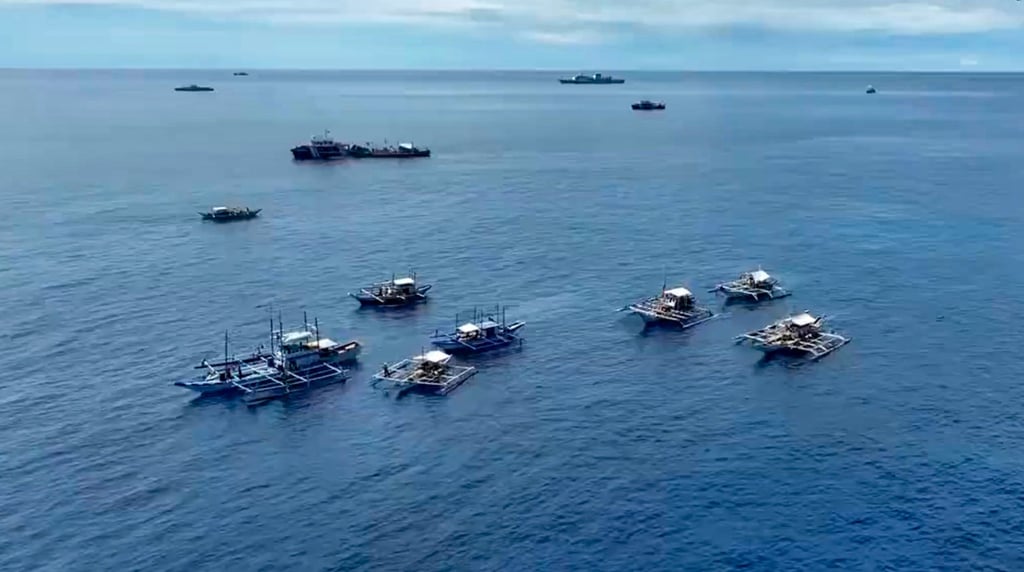A recent move by the Philippines to indefinitely deploy a coastguard vessel to the Sabina Shoal in the South China Sea has raised tensions further in the disputed waterway, with Manila and Beijing both accusing the other of illegally occupying the maritime feature.
Analysts say the shoal, known as Xianbin Jiao in China and Escoda Shoal in the Philippines, could become the next flashpoint in the territorial conflict given its strategic value to both sides.
Manila on Monday rejected a claim by a China Coast Guard spokesperson that the presence of the BRP Teresa Magbanua, a Philippine Coast Guard (PCG) ship stationed at the shoal, violated Beijing’s territorial sovereignty and maritime rights. The Chinese side also claimed the vessel had been “illegally stranded” on the shoal.
Jay Tarriela, PCG spokesman for the West Philippine Sea, denied the accusation, saying the BRP Magbanua had been “intentionally deployed to maintain our presence and ensure the protection of this area of the West Philippine Sea”, referring to the part of the South China Sea that lies within the country’s exclusive economic zone.
“Given our sovereign rights in these waters, the Philippine coastguard can remain there for as long as necessary,” Tarriela added.
Manila has had the BRP Teresa Magbanua deployed to the shoal – a low-tide elevation feature that is part of the Spratly Islands, located 75 nautical miles (139km) from the island province of Palawan – since April to monitor and prevent alleged illegal activities by Chinese vessels.

In May, the Philippines claimed China could be undertaking land reclamation activities near the shoal after crushed corals were found in the area.
Every Saturday
A weekly curated round-up of social, political and economic stories from China and how they impact the world.
By submitting, you consent to receiving marketing emails from SCMP. If you don’t want these, tick here
Over the weekend, the BRP Teresa Magbanua was used to provided Philippine fishermen with fuel subsidies, while Chinese research vessel the Ke Xue San Hao, the China Coast Guard’s largest vessel nicknamed “the Monster”, and 12 Chinese maritime militia were spotted patrolling the area.
Strategic shoal
Jose Antonio Custodio, a defence analyst and fellow at the Consortium of Indo-Pacific Researchers, told This Week in Asia on Tuesday Sabina Shoal could be the next potential flashpoint in the South China Sea conflict.
“The Chinese are trying to inch forward. The Philippines is also trying to protect its line of communication and sovereignty there. The shoal is ideal for forward operating areas … Similar to what the Chinese have done in Mischief Reef, it will allow for the projection of power or the protection of communication lines,” Custodio said.
Mischief Reef, known as Panganiban Reef in the Philippines, has been developed and transformed by China into an artificial island with military installations, including runways and missile systems.
Security analyst Joshua Espeña, a resident fellow and vice-president of the International Development and Security Cooperation, noted that Sabina Shoal is close to Second Thomas Shoal – another disputed maritime feature that has been the site of numerous conflicts between both sides – and a good place for rest and replenishment for small boats.
History, money and military: why the South China Sea is so important to Beijing
The Philippine and China recently said they had reached a deal to de-escalate tensions at Second Thomas Shoal by agreeing to terms under which the Philippines could conduct rotation and resupply (RORE) missions to their outpost there.
Previously, Beijing would attempt to disrupt these missions, which led to numerous clashes. An incident on June 17 left several members of the Philippine navy injured, including one who lost a thumb.
Espeña said maintaining a presence at Sabina Shoal would give China more power to enforce its terms over RORE missions.
“This is something that the Philippines must counter, given the critical value of a symmetric enforcement of the RORE. If not, the Philippines might be in a bad position in the long term,” Espeña told This Week in Asia.
He also noted that Sabina would serve as a good forward operating base for the People’s Liberation Army’s Southern Theatre Command.
Sherwin Ona, an associate professor of political science at De La Salle University in Manila, said it was not difficult to imagine that Sabina Shoal would become a flashpoint since it was the “scene of an environmental crime”, given the accusations that China had destroyed coral for illegal land reclamation activities.
“The current situation shows that the Philippines needs bigger ships that can stay in an area for longer periods. This underscores the need for the PCG to invest in floating platforms,” he said.
Ray Powell, a maritime security analyst at the Gordian Knot Center for National Security Innovation at Stanford University, said Beijing had stationed its ships at Sabina Shoal for years, but the Philippines’ recent investigation revealing apparent preliminary reclamation activity forced Manila to deploy the BRP Teresa Magbanua to monitor and contest China’s attempt to lay claim to this feature.
“This unexpected move has clearly aggravated Beijing, which has responded by sending in larger militia as well as coastguard vessels, including the 12,000-ton ‘Monster’ ship, which remains there now,” Powell told This Week in Asia.
Manila and Beijing have been locked in an increasingly contentious territorial row in the South China Sea in recent months. A tribunal in The Hague ruled in 2016 that Beijing’s claims over the South China Sea through its so-called nine-dash line had no legal basis and recognised Manila’s sovereign rights in the waterway. China, however, has refused to accept the ruling and continues to assert claims over maritime features such as the Sabina Shoal.
scmp.com

